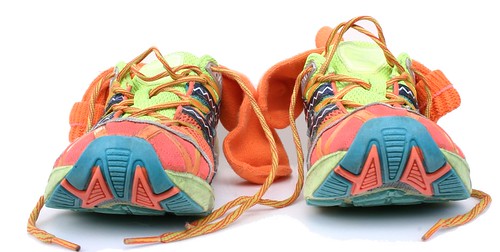
The percentage of overweight children in the United States is growing at an alarming rate. On the whole, kids are spending less time exercising and more time in front of the TV, computer, or video-game console. And today's busy families have fewer free moments to prepare nutritious, home-cooked meals, day in and day out. From fast food to electronics, quick and easy seems to be the mindset of many people, young and old, in the new millennium.
Since the 1970s, the percentage of overweight kids and adolescents in the United States has more than doubled. Today, 10% of 2- to 5-year-olds and more than 15% of children between the ages of 6 and 19 are overweight. If you combine the percent of kids who are overweight with the percent of kids who are at risk of becoming overweight, about one out of three children are affected.
Preventing your children from becoming overweight means adapting the way you and your family eat and exercise and the way you spend time together. Helping your children lead healthy lifestyles begins with you, the parent, and leading by example.
Is Your Child Overweight?
A child with a body mass index at or above the 95th percentile for age and sex is considered overweight. BMI uses height and weight measurements to estimate how much body fat a person has. To calculate your child's BMI, divide his or her weight by his or her height squared, or wt/ht2. (Important: To use this formula for BMI, the child's weight and height measurements must be in kilograms and meters, respectively. If you use pounds and inches, multiply the result by the conversion factor 703.)
An easier way to get your child's BMI is to use a BMI calculator. Once you know your child's BMI, it can be plotted on a standard BMI chart. Your child will fall into one of 4 categories:
- Underweight: BMI below the 5th percentile
- Normal weight: BMI falls between the 5th and the 85th percentiles
- At risk for overweight: BMI between the 85th and 95th percentiles
- Overweight: BMI at or above 95th percentile
BMI is not a perfect measure of body fat and there are situations where BMI may be misleading. For example, a very muscular person may have a high BMI without being overweight (because extra muscle adds to a person's body weight - but not fatness). In addition, BMI may be difficult to interpret during puberty when kids are experiencing periods of rapid growth. It's important to remember that BMI is usually a good indicator - but is not a direct measurement - of body fat.
These days, you may be hearing more about BMI. Doctors are using BMI during routine check-ups and many school districts are including BMI in their annual health assessments.
If you're worried that your child or teen may be overweight, make an appointment with your child's doctor. If your child is overweight, your doctor may ask about your child's eating and activity habits and make suggestions on how to make positive changes. He or she may also decide to screen for some of the medical conditions that can be associated with obesity (see below). Depending on the child's BMI, age, and health, the doctor may refer you to a registered dietitian for additional advice. For some overweight children, your doctor may recommend a comprehensive weight management program.
The Effects of Overweight
Overweight children are at risk for serious health conditions like type 2 diabetes, high blood pressure, and high cholesterol - all once considered exclusively adult diseases. But overweight children may also be prone to low self-esteem that stems from being teased, bullied, or rejected by peers. Overweight children are often the last to be chosen as playmates, even as early as preschool. Children who are unhappy with their weight may be more likely than average-weight children to develop unhealthy dieting habits and eating disorders, such as anorexia nervosa and bulimia, and they may be more prone to depression, as well as substance abuse.
Overweight children are at risk of developing medical problems that affect a child's present and future health and have direct impact on quality of life including:
- high blood pressure, high cholesterol and abnormal blood lipid levels, insulin resistance, and type 2 diabetes
- bone and joint problems
- shortness of breath that makes exercise, sports, or any physical activity more difficult and may aggravate the symptoms or increase the chances of developing asthma
- restless or disordered sleep patterns
- tendency to mature earlier (overweight kids may be taller and more sexually mature than their peers, raising expectations that they should act as old as they look, not as old as they are; overweight girls may have irregular menstrual cycles and have fertility problems in adulthood)
- liver and gall bladder disease
- depression
Risk factors present in childhood (including high blood pressure, high cholesterol, and diabetes) can lead to serious adult medical conditions like heart disease, heart failure, and stroke. Preventing or treating obesity in children may reduce the risk of developing these conditions as they get older.
What Causes Overweight?
There are a number of factors that contribute to becoming overweight, either alone or together. Genetic factors, lifestyle habits, or both may be involved. In some instances, endocrine problems, genetic syndromes, and medications can be associated with excessive weight gain.
Much of what we eat is quick and easy - from fat-laden fast food to microwave and prepackaged meals. Daily schedules are so jam-packed that there's little time to prepare healthier meals or to squeeze in some exercise. Portion sizes, in the home and out, have drastically increased.
Plus, now, more than ever, life is sedentary - children spend more time playing with electronic devices, from computers to handheld video game systems, than actively playing outside. Television is a major culprit.
Kids younger than 8 spend an average of 2.5 hours watching TV or playing video games, and kids 8 and up spend 4.5 hours plopped in front of the TV or wriggling a joystick. Kids who watch more than 4 hours a day are more likely to be overweight compared with kids who watch 2 hours or less. Not surprisingly, TV in the bedroom is also linked to increased likelihood of being overweight. In other words, once many kids get home from school, virtually all of their free time before dinner, doing homework, and getting ready for bed is spent in front of one screen or another!
And although physical education (PE) in schools can help kids get up and moving, more and more schools are cutting PE programs altogether or cutting down on the amount of time spent actually doing fitness-building physical activities. One study showed that gym classes offered third graders just 25 minutes of vigorous activity each week.
Genetics also plays a role - genes help determine your body type and how your body stores and burns fat just like they help determine other traits. Because both genes and habits can be passed down from one generation to the next, multiple members of a family may struggle with weight.
A greater reliance on "food fixes" to deal with emotions can also contribute to weight gain. Some people tend to eat more when they're feeling sad, stressed, or bored. People in the same family tend to have similar eating patterns, maintain the same levels of physical activity, and adopt the same attitudes toward being overweight. Studies have shown that a child's risk of obesity greatly increases if one or more parent is overweight or obese.
Overcoming Overweight and Obesity in Your Child
The key to keeping kids of all ages at a healthy weight is taking a whole-family approach. It's the "practice what you preach" mentality. Make eating and exercise a family affair. Get your children involved by letting them help you plan and prepare healthy meals, and take them along when you go grocery shopping, so they can learn how to make good food choices.
Avoid falling into some common food/eating behavior traps:
- Don't reward children for good behavior or try to stop bad behavior with sweets or treats. Come up with other solutions to modify their behavior.
- Don't maintain a clean-plate policy. Be aware of kids' hunger cues. Even babies who turn away from the bottle or breast send signals that they're full. If kids are satisfied, don't force them to continue eating. Reinforce the idea that they should only eat when they're hungry.
- Don't talk about "bad foods" or completely eliminate all sweets and favorite snacks from overweight children's diets. Children may rebel and overeat these forbidden foods outside the home or sneak them in on their own.
Here are some additional recommendations for children of all ages:
- Birth to age 1: In addition to it's many health benefits, breastfeeding may help prevent excessive weight gain. Though the exact mechanism is not known, breastfed babies are more able to control their own intake and follow their own internal hunger cues.
- Ages 2 to 6: Start good habits early. Encourage kids' natural tendency to be active and offer children a variety of healthy foods. It may take 10 or more tries before a child will accept a new food, so don't give up.
- Ages 7 to 12: Encourage children to be physically active every day, whether it's an organized sports team or a pick-up game of soccer during recess. Keep your kids active at home, too, through everyday activities like walking and playing in the yard. Let them be more involved in making good food choices.
- Ages 13 to 17: Teens like fast-food, but try to steer them toward healthier choices like grilled chicken sandwiches, salads, and smaller sizes. Encourage them to be active everyday. If they are not into organized sports, suggest intramural programs, fitness classes such as yoga or pilates, or alternative sport like skateboarding, inline skating, or mountain biking.
- All ages: Cut down on TV, computer, and video game time and discourage eating while watching the tube. Serve a variety of healthy foods and eat meals together as often as possible. Try to include 5 servings of fruits and vegetables a day in their diet, plan healthy snacks, and encourage kids to eat breakfast every day. Encourage your children to try a variety of activities. Don't force any one sport or activity - and help them find what they enjoy and then support them in their efforts.
If you, as a parent, eat well and exercise regularly and incorporate healthy habits into your family's daily life, you're modeling a healthy lifestyle for your children that could last into adulthood. Talk to your kids about the importance of eating well and being active, but make it a family affair that will become second nature for both you and your children. Most of all, let your children know you love them - no matter what their weight - and that you want to help your child be happy and healthy.

If you would like your child to participate in a healthy, fun, exercise program please contact Sarah Lowe at:
sarahlowefitness@bellsouth.net





